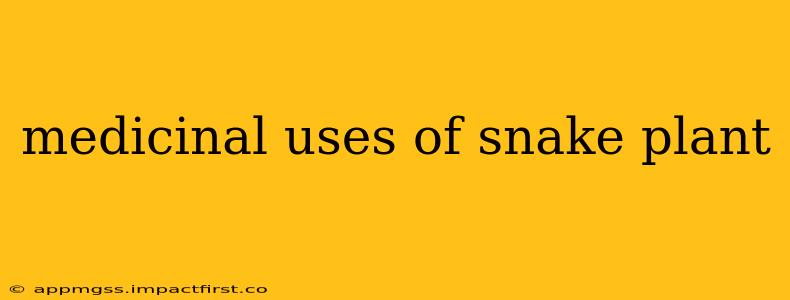The snake plant, Sansevieria trifasciata, also known as mother-in-law's tongue, is a popular houseplant prized for its air-purifying qualities and striking appearance. But beyond its aesthetic appeal, this resilient plant holds a place in traditional medicine and is increasingly being studied for its potential therapeutic properties. While it's crucial to remember that snake plant should not be considered a replacement for professional medical advice or treatment, exploring its historical and current uses provides fascinating insight into its potential.
What are the claimed medicinal benefits of snake plant?
Historically, various parts of the snake plant have been utilized in traditional medicine, primarily in parts of Asia and Africa. Claims surrounding its medicinal benefits often center around its ability to treat a range of ailments, although robust scientific evidence supporting many of these claims is limited. Traditional uses often involve topical applications of the plant's extracts or ingestion of prepared parts, but these practices should only be undertaken with extreme caution and under the guidance of qualified professionals knowledgeable in traditional medicine.
Does snake plant have any antimicrobial properties?
Research suggests that snake plant extracts exhibit some antimicrobial properties. Studies have indicated the presence of compounds within the plant that may inhibit the growth of certain bacteria and fungi. However, more extensive research is needed to fully understand the mechanism of action and the efficacy of these antimicrobial properties in a clinical setting. These findings are promising, but should not be interpreted as a guarantee of effectiveness against all microbial infections.
Can snake plant juice be used for any health condition?
The use of snake plant juice for medicinal purposes is rooted in traditional practices. However, it's vital to emphasize that ingesting snake plant juice is not recommended without consulting a medical professional. The plant contains compounds that, in certain concentrations or preparations, could potentially be harmful if ingested. While some traditional uses exist, modern medicine hasn't validated the safety or efficacy of ingesting snake plant juice for treating specific health conditions.
Is snake plant poisonous to humans?
While snake plant is generally considered non-toxic to humans, it's important to note that ingestion of large quantities of the plant's leaves can cause mild gastrointestinal upset, such as nausea or vomiting. Skin contact with the sap may also cause irritation in sensitive individuals. Therefore, it's crucial to handle the plant with care, especially if you have children or pets. Keep the plant out of reach of small children and animals.
What are the different ways snake plant is used medicinally?
Historically, snake plant has been used in various ways depending on the specific culture and the ailment being addressed. These methods often involved topical applications of crushed leaves or sap to treat skin conditions, or internal use of decoctions prepared from the plant's roots, which are practices requiring significant caution and professional guidance. It is crucial to remember that these traditional uses should not be interpreted as endorsements for self-medication.
Are there any scientific studies supporting the medicinal uses of snake plant?
While anecdotal evidence and traditional uses of snake plant exist, the scientific community requires more rigorous research to fully understand and validate its potential medicinal benefits. Many studies are preliminary and focus on specific compounds found within the plant rather than the whole plant itself. More extensive clinical trials and research are essential to confirm and clarify any potential therapeutic applications.
Disclaimer: This information is for educational purposes only and should not be considered medical advice. Always consult a qualified healthcare professional before using snake plant or any other plant for medicinal purposes. Self-treating can be dangerous and may delay or hinder proper medical care.
